Juanita Micaceous Taos Pueblo Pottery Pitcher Native American Indian Folk Art Na

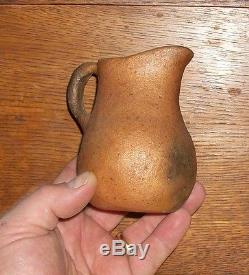
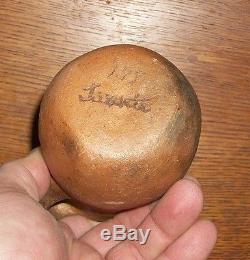

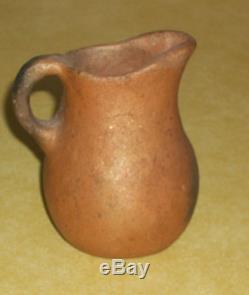
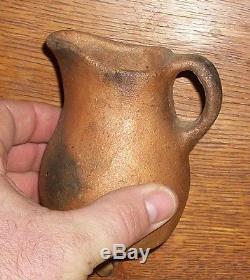
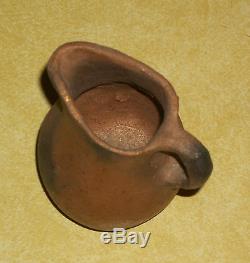

JUANITA MICACEOUS TAOS PUEBLO POTTERY PITCHER NATIVE AMERICAN INDIAN FOLK ART NA. We welcome any comments, questions, or concerns. WE ARE TARGETING A GLOBAL MARKET PLACE. Thanks in advance for your patronage.
Please Be sure to add WDG to your. NOW FOR YOUR VIEWING PLEASURE. MEASURES ABOUT 8cm X 10cm X 8cm. An older hand formed piece from the Taos Pueblo is of micaceous clay.The clay, most frequently found in the Sangre de Christo Mountain Range, is rich in Mica, which not only gives the sparkling appearance to the bowl but also adds strength to the piece making micaceous pottery well suited for cooking. Traditionally fired in an open pit using wood and bark from the Pinon and Ponderosa pine these beautiful pieces often are marked with gray smoke or "fire clouds" resulting from touching or being very near to the burning timber. Native American pottery is an art form with at least a 7500-year history in the Americas. Pottery is fired ceramics with clay as a component.
Ceramics are used for utilitarian cooking vessels, serving and storage vessels, pipes, funerary urns, censers, musical instruments, ceremonial items, masks, toys, sculptures, and a myriad of other art forms. Due to their resilience, ceramics have been key to learning more about Precolumbian indigenous cultures. Materials and techniques The clay body is a necessary component of pottery. Clay must be mined and purified in an often laborious process, and certain tribes have ceremonial protocols to gathering clay.Different tribes have different processes for processing clay, which can include drying in the sun, soaking in water for days, and repeatedly running through a screen or sieve. Acoma and other Pueblo pottery traditionally pound dry clay into a powder and then remove impurities by hand, then running the dry powder through a screen, mixing it with a dry temper, and then mixing water to create a plastic paste. In preparing the clay, potters spend hours wedging it to remove air pockets and humidity that could easily cause it to explode during firing. The clay then needs to "cure" over time. Coiling is the most common means of shaping ceramics in the Americas.
In coiling, the clay is rolled into a long, thin strands that are coiled upon each other to build up the shape of the pottery. While the potter builds the coils up, she also blends them together until there was no trace of the ropes of clay entwined to form the pot, no deviation in the thickness of the walls, and therefore no weaknesses. Potter's wheels were not used prior to European contact and are only used today by a limited number of Native American artists. Pinch pots and other small clay objects could be formed directly by hand. Hohokam potters and their descendents in the American Southwest employed the paddle-and-anvil technique, in which the interior clay wall of a pot was supported by an anvil, while the exterior was beaten with a paddle, smoothing the surface. In precontact South America, ceramics were mass-produced using molds.Slip is a liquid clay suspension of mineral pigments applied to the ceramics before firing. Slips are typically red, buff, white, and black; however, Nazca culture ceramic artists in Peru perfected 13 distinct colors of slips. They also used a hand-rotated turntable that allowed all sides of a ceramic piece to be painted with ease. These were first used in 500 BCE and continue to be used today. Slips can be applied overall in washes, creating large color fields, often with cloth, or they can be painted in fine detail with brushes.
Yucca leaves, chewed slightly to loosen fibers, make excellent brushes that are still in use today in the American Southwest. Negative painting is a technique employed by precontact Mississippian potters in the Eastern Woodlands, Mayan potters in Mesoamerica, and others, which involves covering the ceramic piece in beeswax or another resist, incised a design in the resist, then soaking the piece with a slip. In the firing process the resists melts away, leaving the colored design. While still green, pottery can be incised with designs. Cords, textiles, baskets, and corncobs have been rolled over wet clay, both as a decoration and to improve heat dispersion in cooking pots.Carved wood or ceramic stamping paddles are used throughout the Southeastern Woodlands to create repeating designs. Clay can also be added to the main ceramic structure to build up designs.
Before firing, ceramics can be burnished or polished to a fine sheen with a smooth instrument, usually a stone. Glazes are seldom used by indigenous American ceramic artists. Grease can be rubbed onto the pot as well. Prior to contact, pottery was usually open-air fired or pit fired; precontact Indigenous peoples of Mexico and Pueblo people did make limited use of kilns. Today many Native American ceramic artists use kilns.In pit-firing, the pot is placed in a shallow pit dug into the earth along with other unfired pottery, covered with wood and brush, or dung, then set on fire whereupon it can harden at temperatures of 1400 degrees or more. Finally, the ceramics surface is often polished with smooth stones.
Tempers Tempers are non-plastic materials added to clay to prevent shrinkage and cracking during drying and firing of vessels made from the clay. Tempers may include: Bone; Chaff; Charcoal; Wood ash; Grit; Sand, crushed sandstone; Crushed limestone; Crushed igneous rocks, such as volcanic rock, feldspar, or mica; Grog (crushed potsherds); Plant fiber; Mollusc shells, freshwater and marine (sometimes fossilized), crushed; Freshwater Sponge spicules. Not all Native American pottery requires added tempers; some Hopi potters use pure kaolin clay that does not require tempering. Some clays naturally contain enough temper that they do not required additional tempers. This includes mica or sand in clays used in some Taos Pueblo, Picuris Pueblo, and Hopi pottery, and sponge spicules in the clay used to produce the "chalky ware" of the St.
Ceramics are often used to identify archaeological cultures. The type of temper (or mix of tempers) used helps to distinguish the ceramics produced by different cultures during particular time periods. Grog, sand, and sandstone were all used by Ancestral Pueblo people and other Southwestern cultures.Crushed bone was used as temper in at least some ceramics at a number of sites in Texas. In the Southeastern United States, the earliest ceramics were tempered with fiber such asish moss and palmetto leaves. In Louisiana, fiber as tempering was replaced first by grog and later by shell.
In peninsular Florida and coastal Georgia sand replaced fiber as tempering. Still later, freshwater sponge spicules became an important temper in the "chalky ware" of the St. Johns culture in northeastern Florida. Locally produced ceramics of the Lucayan people in the Bahamas were characterized by crushed conch shell tempering, as opposed to the quartz sand-tempered ware imported from Hispaniola. The choice of temper used in ceramics was constrained by what was available, but changes in the choice of temper can provide clues to influence and trade relations between groups.Shell-tempered ware was produced sporadically in various places across the eastern United States, but in the late Woodland and early Mississippian periods it became the predominant temper used across much of the Mississippi Valley and middle gulf coast, and a major defining characteristic of Mississippian culture pottery. Origin and spread The earliest ceramics known from the Americas have been found in the lower Amazon Basin.
Ceramics from the Caverna de Pedra Pintada, near Santarém, Brazil, have been dated to 7,500 to 5,000 years ago. Ceramics from Taperinha, also near Santarém, have been dated to 7,000 to 6,000 years ago. Some of the sherds at Taperinho were shell-tempered, which allowed the sherds themselves to be radiocarbon dated.
These first ceramics-making cultures were fishers and shellfish-gatherers. Ceramics appeared next across northern South America and then down the western side of South America and northward through Mesoamerica. Ceramics of the Alaka culture in Guyana have been dated to 6,000 to 4,500 years ago.Ceramics of the San Jacinto culture in Colombia have been dated to about 4530 BCE, and at Puerto Hormiga, also in Colombia, to about 3794 BCE. Ceramics appeared in the Valdivia culture in Ecuador around 3200 BCE, and in the Pandanche culture in Peru around 2460 BCE. The spread of ceramics in Mesoamerica came later.
Ceramics from Monagrillo in Panama been dated to around 2140 BCE, from Tronadora in Costa Rica to around 1890 BCE, and from Barra in Guatemala to around 1682 BCE. Ceramics of the Purrón tradition in southcentral Mexico have been dated to around 1805 BCE, and from the Chajil tradition of northcentral Mexico, to around 1600 BCE.The appearance of ceramics in the Southeastern United States does not fit the above pattern. Ceramics from the middle Savannah River in Georgia and South Carolina known as Stallings, Stallings Island, or St.
Simons have been dated to about 2888 BCE (4500 BP), and ceramics of the Orange and Norwood cultures in northern Florida to around 2460 BCE (4300 BP) (all older than any other dated ceramics from north of Colombia). Ceramics appeared later elsewhere in North America. Ceramics reached southern Florida (Mount Elizabeth) by 4000 BP, Nebo Hill (in Missouri) by 3700 BP, and Poverty Point (in Louisiana) by 3400 BP. (THIS PICTURE FOR DISPLAY ONLY).
DO NOT BE TOO PERSNICKETY. Please leave feedback when you have received the item and are satisfied.
Our goal is for 5-star service. We want you to be a satisfied, return customer. Please express any concerns or questions. More pictures are available upon request. Please Check out our other items. WE like the curious and odd. The item "JUANITA MICACEOUS TAOS PUEBLO POTTERY PITCHER NATIVE AMERICAN INDIAN FOLK ART NA" is in sale since Friday, January 6, 2017. This item is in the category "Pottery & Glass\Pottery & China\Art Pottery\Other American Pottery".The seller is "cbenhob" and is located in Jenks, Oklahoma. This item can be shipped worldwide.
- Main Color: RUTILE

